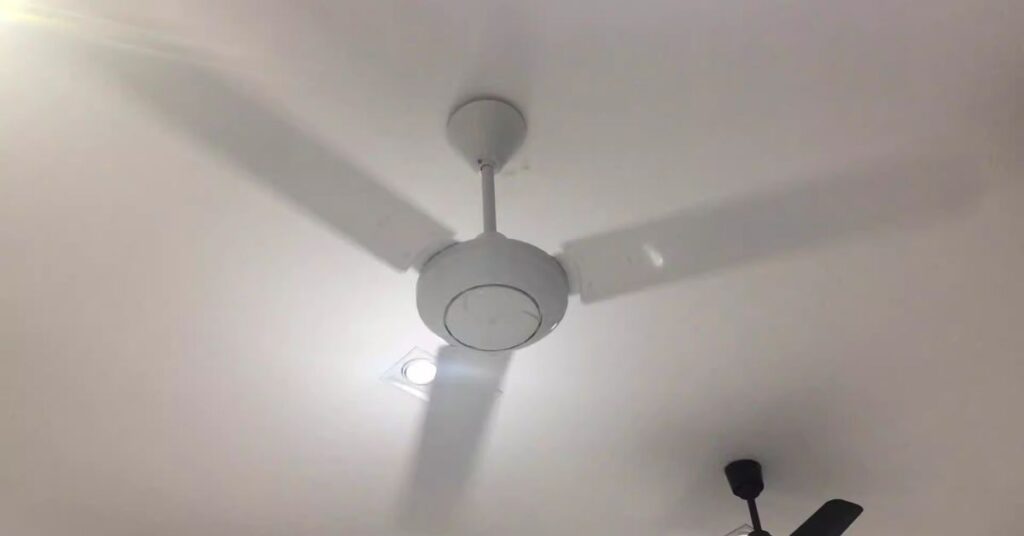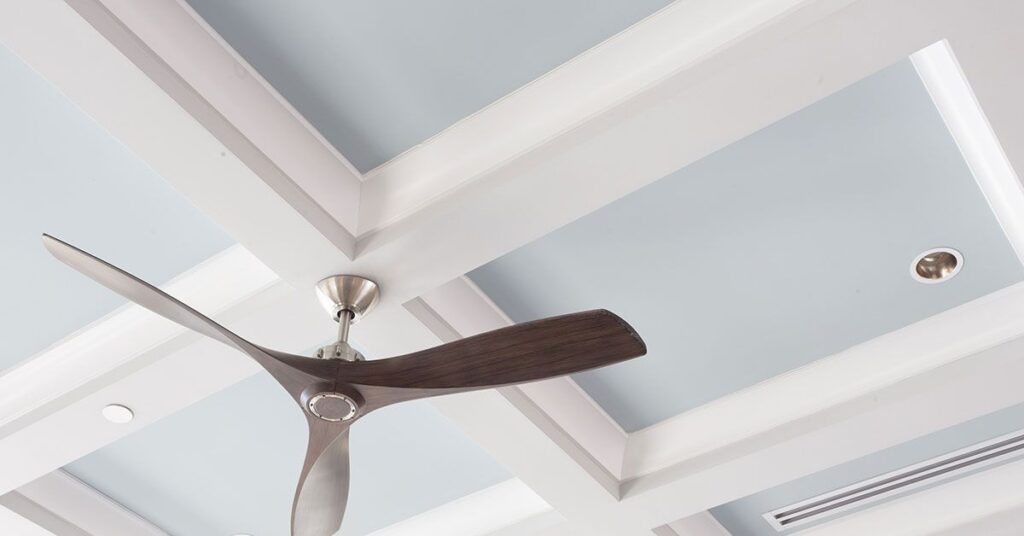Selecting the right ceiling fan for your room is crucial for both comfort and aesthetics. A fan that’s too small won’t circulate air effectively, while an oversized fan can overwhelm the space and create an unpleasant draft.
The key to choosing the perfect ceiling fan lies in accurately measuring your room and understanding how these measurements translate to fan size. This comprehensive guide will walk you through the process of measuring your room for a ceiling fan, ensuring you make an informed decision for your space.
Why Does Room Size Matter for Ceiling Fans?

Before diving into the measurement process, it’s essential to understand why room size is so critical when selecting a ceiling fan.
The size of your room directly impacts the air circulation and cooling efficiency of the fan. A properly sized fan will create a comfortable airflow throughout the entire space, helping to maintain a consistent temperature and reduce energy costs.
In larger rooms, a small fan may struggle to move enough air, resulting in hot spots or areas where the cooling effect is minimal. Conversely, in a small room, an oversized fan can create an uncomfortable, blustery environment and may even pose safety risks due to its proximity to walls or other objects.
By taking accurate measurements and following this guide, you’ll be able to choose a ceiling fan that not only fits your room perfectly but also enhances its functionality and appearance.
READ THIS BLOG : How to Read a Tape Measure for Beginners? (The Easiest Way)
Tools Needed
Before you begin measuring your room, gather the following tools to ensure accurate measurements:
- Tape measure
- Calculator
- Notepad and pen
- Step ladder (for measuring ceiling height)
- Helper (optional, but recommended for larger rooms)
Having these tools on hand will make the measuring process smoother and more precise, setting you up for success in selecting the ideal ceiling fan for your space.
A Step-by-Step Guide to Measuring Your Room
Step 1: Measure the length and width of the room

Start by measuring the length of your room. Use your tape measure to determine the distance from one wall to the opposite wall. Be sure to measure at the widest point of the room for accuracy. Record this measurement in your notepad.
Next, measure the width of the room using the same technique. Again, measure at the widest point and record the result.
For irregularly shaped rooms, such as L-shaped spaces, break the room into rectangles and measure each section separately. You’ll need to calculate the square footage for each section and then add them together for the total room size.
Step 2: Calculate the Square Footage
To calculate the square footage of your room, simply multiply the length by the width. For example, if your room is 12 feet long and 10 feet wide, the calculation would be:
12 feet x 10 feet = 120 square feet
For irregularly shaped rooms where you’ve measured multiple sections, calculate the square footage of each section and then add them together for the total.
Step 3: Consider the Ceiling Height
While not directly related to the fan size, ceiling height is an important factor to consider when choosing a ceiling fan. Use your step ladder to safely measure from the floor to the ceiling. This measurement will help you determine whether you need a flush mount, downrod, or angled mount fan.
For ceilings 8 feet high or less, a flush mount or low-profile fan is typically recommended. For ceilings between 8 and 9 feet, a standard mount with a short downrod usually works well. Ceilings higher than 9 feet often require longer downrods to bring the fan to an optimal height for air circulation.
Choosing the Right Fan Size Based on Room Measurements

Now that you have your room’s square footage and ceiling height, you can use this information to select an appropriately sized ceiling fan. The blade span of a ceiling fan is typically measured in inches and refers to the diameter of the circle created by the spinning blades.
Fan Size Chart

Use this general guideline to match your room’s square footage to an appropriate fan size
| Room size (square feet) | Recommended Blade Span (inches) |
| Up to 75 | 29 to 36 |
| 76 to 144 | 36 to 42 |
| 145 to 225 | 44 to 48 |
| 226 to 400 | 50 to 54 |
| Larger rooms | Consider using multiple fa |
Remember, these are general guidelines. The best fan size may vary depending on the room’s shape, ceiling height, and intended use.
Tips for Considering Fan Blade Span and Room Type
When selecting a fan size, consider the primary function of the room. For example:
- Bedrooms often benefit from smaller, quieter fans that provide gentle air circulation.
- Living rooms and family rooms typically require larger fans to effectively cool the space and accommodate higher ceilings.
- Kitchens may need smaller fans due to space constraints and the presence of other appliances.
- Outdoor spaces like patios or porches often require larger, weather-resistant fans to combat humidity and provide adequate airflow.
Additional Considerations
Room Shape and Obstacles
While square footage is a crucial factor, the shape of your room and any obstacles within it can also impact your fan choice. Consider these factors:
- For long, narrow rooms, you might opt for multiple smaller fans rather than one large one to ensure even air distribution.
- Take note of any ceiling obstructions like light fixtures, beams, or sloped ceilings that might affect fan placement or require special mounting options.
- Consider the furniture layout in your room. Ensure that the fan blades will have adequate clearance from tall furniture or cabinet tops.
Types of Ceiling Fans

There are various types of ceiling fans designed for different purposes and room styles:
- Standard ceiling fans are the most common and versatile option for most indoor spaces.
- Low-profile fans are ideal for rooms with lower ceilings, typically 8 feet or less.
- Dual-motor fans offer a unique design and can be effective in large or long rooms.
- Outdoor ceiling fans are specially designed to withstand moisture and weather conditions.
- Energy Star certified fans are more energy-efficient and can help reduce electricity costs.
Energy Efficiency
When selecting a ceiling fan, consider its energy efficiency. Look for fans with Energy Star certification, which indicates they meet strict energy efficiency guidelines set by the U.S. Environmental Protection Agency and the Department of Energy. These fans can help you save on energy costs while still providing excellent air circulation.
Additionally, consider fans with reversible motors. These allow you to change the direction of the blades, pushing warm air down in winter and creating a cooling effect in summer, making the fan useful year-round.
READ THIS BLOG: 12 Things That Have an Area of 10 Square Feet
Frequently Asked Question
How high should a ceiling fan be from the floor?
Ideally, ceiling fans should be 7-9 feet from the floor for optimal air circulation.
Can I install a ceiling fan in a room with a sloped ceiling?
Yes, with a special angled mount adapter designed for sloped ceilings.
How much clearance do I need between the fan blades and the walls?
Maintain at least 18 inches of clearance between the blade tips and walls.
Are bigger fan blades always better?
Not necessarily. The ideal blade size depends on your room’s dimensions and intended use.
How do I measure the blade span of a ceiling fan?
Measure from the tip of one blade to the tip of the opposite blade when the blades are fully extended.
Conclusion
Measuring your room accurately is the first and most crucial step in selecting the perfect ceiling fan. By following this guide, you’ve learned how to measure your room’s length, width, and height, calculate its square footage, and use this information to choose an appropriately sized fan.
Remember to consider factors beyond just size, such as room shape, obstacles, ceiling height, and the room’s primary function. By taking all these elements into account, you’ll be well-equipped to select a ceiling fan that not only fits your space perfectly but also enhances its comfort, functionality, and style.

Anthony is a seasoned SEO expert with a passion for content writing, keyword research, and web development. He combines technical expertise with creative strategies to deliver exceptional digital solutions.












